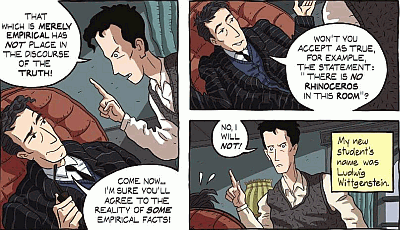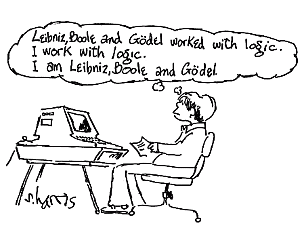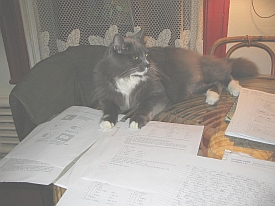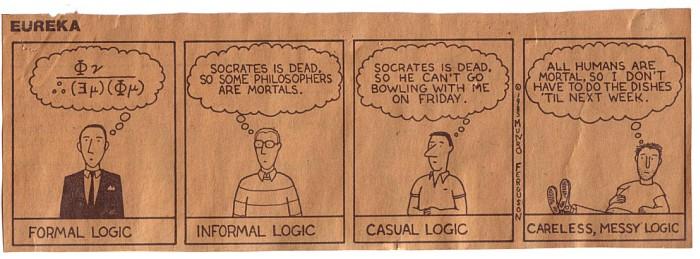
Maths & Logic (Fall 2011)
Marks
Test Marks
(etc.)
 I have posted the final grades here; they have been sent to the
college as well. At this point, changes must go through official channels.
I have posted the final grades here; they have been sent to the
college as well. At this point, changes must go through official channels.
Congratulations: (most of) you passed the course with grace and
dignity. I wish you all the best with your other studies, and have a
great (and well deserved) vacation.
I'd love to have your feedback about
the course, etc (your chance to comment!).
Now that we've finished the course, here's a suggestion:
read the first 4 or 5 pages of the book again - it should all make a
lot more sense this time round. (And you get to enjoy my prose once
more ... )
Check out my "science & maths reading
list" for some leisure reading over the holidays.
Selected readings
The main readings for this course come from my text
Principles
of Mathematics and Logic. Individual chapters are
cited below, unit by unit, so you know when you should read each
chapter (two chapters per unit). A copy of an older edition of the
text is also available on reserve in the library.
(Use this when you
need to but be sure to check with your copy of the current edition
afterwards - changes have been made and typos fixed.)
In addition, some sections of another text, the Alberta
Notes may also be useful - I have made two chapters available
suitably linked in the units where they are relevant. You should be
aware that this
and other texts may treat the material differently
from my text - in cases where there are differences, my text is
definitive for the purposes of this course.
You should also look at the Entertainments section below.
Problems?
Click here if you are having trouble
with PDF files.
Note: When you read mathematics, it is important
to engage the text actively, not passively. You should have pencil
and paper beside you, and try to follow each statement,
doing the suggested calculations or reasoning yourself. It
is not a novel or short story, whose meaning will just flow over you,
but a dialogue, only one side of which is on the page. You must
provide the other side yourself!
Here is an
excellent article on how to read mathematics if you want more
"advice".
(BTW: the book [Emblems of Mind by Edward
Rothstein]
from which the quotes are taken is one I recommend in the
Entertainments below. It's about
Maths & Music, and might give you a different insight into the
nature of maths.)
Note: If you find typos or other errors, or if you have questions
about the text, please let me know.
Unit 1
- Chapter 1: Introduction
- Chapter 2: Formal Proof
- Other references that might be of interest:
- History of logic,
filling in the sketchy remarks I made on the history of logic (by King
& Shapiro)
- Alberta Notes on translation from
English into symbolic language and on truth tables.
Unit 2
- Chapter 3: Fitch-style Natural Deduction Rules
- The next two items may help you should you want even more text to
read. BUT: read this first!
- Chapter 4: Analytic Tableaux
- If you want some extra material on Analytic Tableau:
- Interlude
(Notes on various other logics.)
Unit 3
- Chapter 5: Predicate Logic
- The following notes from the Alberta Notes might be helpful
- Reading assignment:
- Chapter 6: Sets
Unit 4
- Chapter 7: Numbers
- Chapter 8: Number Theory (including
the Fundamental Theorem of Arithmetic)
- An alternate proof of the Fundamental Theorem of Arithmetic
Please read my note about calculators
Unit 5
- Chapter 9: The Axiomatic Method
(Boolean and Heyting algebras)
-
Extra reading for this section:
We shall cover the second of the following topics this semester
Gödel's Incompleteness Theorem
-
Chapter 10, section 1:
Gödel's Incompleteness Theorems
-
Extra reading for this section:

Categories, logics, & linguistics
-
Chapter 10, section 2: Categorial Grammar
-
Extra reading for this section:
Probability and Statistics
-
Chapter 11 etc.
(by G. LaValley)
Entertainments (further readings)
General
Unit 1
- Logicomix:
An Epic Search for Truth by Apostolos Doxiadis et al. A graphic
novel about truth - mathematical, philosophical, and logical truth -
and the attempt to base mathematics on a sound logical foundation,
based on events in the life of Bertrand Russell. You will recognise
many people and things from the course in this: Russell, Gödel,
Boole, Cantor, Frege, Wittgenstein, logical proof, infinity,
incompleteness, and more.
- Three scenes from Monty Python (and the Holy Grail):
Witch scene
Three Questions
Knights who say Ni
- And from Labyrinth:
a Knights & Knaves problem
-
Shed some light on truth tables
- Logic
and Humour
- The
Mathematical Experience by Philip Davis & Reuben Hersh. An
excellent introduction to the essence of mathematics.
- Emblems
of Mind by Edward Rothstein. An excellent book on "The Inner Life
of Music and Mathematics" - it gives the layman a good idea of the
essentially creative aspects of maths (and music too!).
- How Mathematicians Think, by William Byers. A
recent book (by a Montreal mathematician) which gives an
overview of the role of ambiguity, as opposed to logic, in mathematics.
(These actually work together to create the mathematical experience.)
- The
Unreasonable Effectiveness of Mathematics
- Other book
suggestions (for maths & science - indeed, for general
enlightenment and entertainment.)
Unit 2,3
Unit 4

Unit 5
Unit on Gödel's Incompleteness Theorem
Unit on Categories, logics, & linguistics
Assignments and Answers
The most important part of the course - in fact, the core of
the course - is the assignments you will find in the text. Nothing is
more important: they are the means whereby you teach
yourself the relevant material, which is far more
important than anything I might try to teach you!
Note: If you find typos or other errors, or if you have questions about
my answers, please let me know.
Additional assignments, comments, solutions, and helpful hints will be
posted in this section of the webpage, as relevant. I'll alert you to
any additions in class.
Unit 1: Your first reading assignment is Chapter 1
You should do the exercises in Chp 1, especially (Parsing)
Exercise 1.3.6; (Substitution) Exercise 1.3.8; (Truth tables)
Exercise 1.3.10; (Tautology) Exercise 1.3.15; (Translation)
Exercises 1.4.1, 1.4.2.
Next, try the Knights & Knaves Problems
(Exercises 1.5.1).
In addition, you will need to read Chapter 2 before the first test.
Unit 2: The main emphasis in this section is Chapter 3. Be sure
to read this chapter carefully, and to do all the exercises. This is a
tricky topic - some find it the hardest of the course - but if you pay
attention to what you can learn from the exercises, you will succeed.
Ask me for help if you need it.
Step-by-step explanation of the
"Vulcans, Romulans, and Klingons" problem. (End of section 3.2)
Summary sheet for natural
deduction (Big print
version for those with poor eyesight)
The exercises done in class
(with answers)
(These also appear in the book.)
Chapter 4 is somewhat less technically demanding, but again, do the
exercises to get a feel for this topic.
We did a worksheet on tableaux (and more derivations!) in Friday's class:
Here are the exercises and solutions to
that worksheet done in class. (This is the corrected version.)
There are some errors in the textbook on pages 91, 95, and 98:
here are corrected versions of
those pages.
Unit 3: Read Chapter 5 carefully.
This unit continues Unit 2 - in particular, you still need to be
able to construct derivations for arguments, but now in predicate
logic as well. There is a lot of help in the examples in the text - do
them carefully, and of course, do the exercises.
Solutions to the workshop problems (and
the problems themselves if you've lost your copy)
The strategy sheet is still useful
as it includes the quantifier rules. (Similarly, for the
2-pages-in-1 version.)
You are required also to read the book/article
On Bullshit by Harry Frankfurt. You should also look at some
of the other readings about his article, as given above.
Read Chapter 6 - Set theory. This should be somewhat less
stressful, after the rigours of predicate logic. As ever: do the exercises.
Unit 4: Read Chapters 7 and 8 (Numbers and Number Theory).
Worksheet for Test 4
Worksheet Solutions
Remember:
you will need a simple (cheap!) calculator, able to do simple
arithmetic. (Or else you can do the calculations in your head!)
Please do not plan to use your cell phone as a calculator, as
this will not be permitted on the next test (indeed as it is not
permitted on any test).
I have put 2 copies of some extra text on the current material (chapters
7-8) in my "binder" in the Maths Lab (H 203). This should help you if you are
having problems with mathematical induction, as it contains more worked
out examples. You can borrow a copy (from the Maths Lab) and xerox it if
you want.
As always, be sure to do all the exercises.
Unit 5: Read Chapter 9 and section 10.2 of Chapter 10.
As ever, there are exercises in my
text; try them (solutions and/or hints at solutions are given at the
end of the section). They will be the basis of Test 5.
You may also find it helpful (even essential!) to look at the extra readings in the
Entertainments section.
Practice Tests
What to study for Test 1 (9 Sept 11)
Practice Test 1
[Answers]
Practice Test 2 (30 Sept 11)
Some hints at where you can find the solutions.
Practice Test 3 (21 Oct 11 -
moved to 26 Oct)
The relevant derivations can be found in the homework exercises.
If you've not found them yet, try
these hints.
Practice Test 4 (moved to 14 Nov 11)
Please do not write out all the induction problems on your 5 by 3 card.
I will look to see what you have merely copied and what you have
created from your intellect when I grade those questions! "Reminders" are
fine, but full details copied will result in only obtaining partial credit on
the test.
If you want to have a complete example of a math induction
question in your notes, you may use THIS one
from the book.
Test 5 (2 Dec 11)
Hints for Test 5
(And a request for feedback!)
You are permitted to bring to the test an index card (or piece of
paper) 5in by 3in (13cm by 8cm) with whatever notes you want written
on it (but just one side please). Plan it carefully!
I do insist the notes are written by you - no xeroxes!;
do not use somebody else's notes, although you may plan notes together.
Write your name on your notes card -
you must hand in your notes with your test, when you finish it
Friday.
Test Answers

Anti-Spam


 I have posted the final grades here; they have been sent to the
college as well. At this point, changes must go through official channels.
I have posted the final grades here; they have been sent to the
college as well. At this point, changes must go through official channels.






